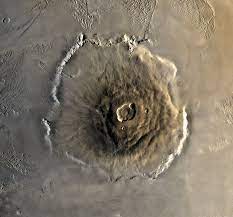Mars, sometimes known as the Red Planet, has been the focal point of human fascination for generations. As our exploration of this nearby planet continues, more concerns concerning the geological characteristics of this world come to light. One of the most common questions people have is whether or not Mars has volcanoes like those found on Earth. It is only natural to question if Mars has a history of volcanic activity comparable to that of our own planet, given the significant impact that volcanoes have had on the terrain and geology of our own planet. In this piece, we will investigate the current understanding of the volcanic activity on Mars and investigate the evidence for volcanic structures that exist on the Red Planet.
In almost every part of the solar system, you may find evidence of volcanic activity. Examples of this natural process that are widely known include the formation of the earth’s volcanoes, such as Mount Etna in Italy and Mauna Loa in Hawaii. Magma is the name given to molten rock that ascends to the surface of the world through breaches in the planetary crust to generate volcanoes. The eruption of this molten material causes the release of gases and lava onto the surface, which results in the formation of a variety of volcanic landforms.
When it comes to Mars, substantial research and observations from a variety of space missions have provided important insights into the geological history of the planet. According to the data, Mars used to be a far more dynamic environment that had a significantly thicker atmosphere, flowing water, and the possibility for volcanic activity. Nevertheless, the most important question is still: Are there any volcanoes on Mars at the present time?
The answer is unequivocally and unequivocally yes. Olympus Mons, which is located on Mars, is the most massive volcano in the solar system. This enormous shield volcano rises more than 21 kilometers (13 miles) into the air and encompasses an area that is about comparable to the size of the state of Arizona. Olympus Mons is a fascinating geological formation that shares many similarities with shield volcanoes that may be seen on Earth, such as Hawaii’s Mauna Loa. Its enormous size and extremely gentle slopes provide evidence that it experienced a continuous eruption over a considerable amount of time.
One of the many examples of volcanic activity on Mars is the mountain known as Olympus Mons. Other famous volcanic features include the Tharsis Montes, a series of three huge shield volcanoes located near the equator, and Elysium Mons, a shield volcano smaller than Olympus Mons but nevertheless of great magnitude. Both of these volcanoes are located on Mars. Strong evidence suggests that Mars was once a volcanically active planet at some point in its history. This evidence comes in the form of several tiny volcanic features as well as larger volcanic formations.
The finding of volcanic landforms on Mars raises some extremely interesting issues regarding the history of the planet and the possibility of further volcanic activity in the future. In spite of the abundant evidence of ancient volcanism, researchers have not found any evidence of active volcanic eruptions on Mars during the time that humans have been observing the planet. On the other hand, it is essential to keep in mind that volcanic activity can be intermittent, with lengthy lulls in between periods of heightened activity. In the future, we may be able to gain a more complete picture of the planet’s current volcanic state as a result of future missions and technical breakthroughs.
The study of Martian volcanoes and the geological characteristics that are connected with them can provide vital insights into the former climate of the planet, the composition of its interior, and even the possibility that there are settings on Mars that are livable. The release of gases into the atmosphere by volcanic activity has the ability to affect the temperature of the planet and create conditions that are favorable to the existence of life. Scientists are hoping that by studying the volcanic processes that take place on Mars, they would be able to solve the puzzles that surround the history of the planet and have a better grasp of the likelihood that Mars has ever hosted life, either in the past or in the present.
In conclusion, Mars does in fact have volcanoes, and Olympus Mons is a witness to the rich geological history of the planet. Mars once experienced a period of significant volcanic activity, which can be deduced from the existence of volcanic landforms on the planet. The likelihood of future volcanic occurrences continues to be an exciting subject of investigation, despite the fact that no active eruptions have been detected thus far. If we keep up our exploration and scientific research on Mars, we might be able to learn more about the planet’s volcanic history, which could have important ramifications for our capacity to comprehend how habitable the red planet actually is.
![]()
